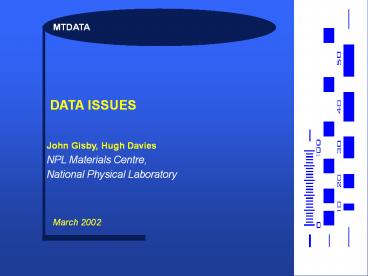MTDATA API - Introduction and Latest Developments - PowerPoint PPT Presentation
1 / 22
Title:
MTDATA API - Introduction and Latest Developments
Description:
Gibbs energy of each phase is ... Enthalpy of mixing 'MISSING DATA' ... CHANGING ENTHALPY / ENTROPY DATA FOR TWO SPINEL UNARIES. TO MODEL DEGREE OF INVERSION, ... – PowerPoint PPT presentation
Number of Views:180
Avg rating:3.0/5.0
Title: MTDATA API - Introduction and Latest Developments
1
MTDATA
DATA ISSUES
John Gisby, Hugh Davies NPL Materials
Centre, National Physical Laboratory
March 2002
2
- DATA ISSUES
- MODELS
- KCl-CaCl2 as an example
- DATA ASSESSMENT
- NiO-Al2O3 as an example
- DATA FOR OXIDE SYSTEMS
- MIRO project RC132
3
- MODELS
- Gibbs energy of each phase is expressed as a
function of - temperature, composition and possibly pressure
- KCl-CaCl2 as an example
4
- Stoichiometric substance or solution phase end
member - GCaKCl3 A BT CTlnT DT2 ET3 F/T
- Solution phase (Redlich-Kister model for Gex)
- GLIQUID xKCl GKCl xCaCl2 GCaCl2
- RT xKClln xKCl RT xCaCl2ln xCaCl2
- Gex
- Gex (L00L01T) xKClxCaCl2
- (L10L11T) xKClxCaCl2 (xKCl-xCaCl2)
- (L20L21T) xKClxCaCl2 (xKCl-xCaCl2)2
5
- GCaKCl3 A BT CTlnT DT2 ET3 F/T
6
- Gex (L00L01T) xKClxCaCl2 (L10L11T)
xKClxCaCl2 (xKCl-xCaCl2) - (L20L21T) xKClxCaCl2 (xKCl-xCaCl2)2
7
- Gex (L00L01T) xKClxCaCl2 (L10L11T)
xKClxCaCl2 (xKCl-xCaCl2) - (L20L21T) xKClxCaCl2 (xKCl-xCaCl2)2
8
- NOT JUST CURVE FITTING
- Underlying thermodynamic properties must be taken
into account - as well as phase boundaries
Enthalpy of mixing
Activity of KCl
9
- MISSING DATA
- If GEX data for a particular interaction are
missing, calculations can be performed assuming
ideal mixing - likely to be OK for interactions between minor
species, - but not for major species
10
- DATA ASSESSMENT
- NiO-Al2O3 as an example
- EXPERIMENTAL DATA
- phase diagram (1963)
- liquidus points (1932)
- compositions of spinels in equilibrium with Al2O3
(1965, 1981 and others) - thermodynamic properties of NiAl2O4 spinel
- degree of inversion of NiAl2O4 spinel (1989,
1992 and earlier)
11
SPINEL MODEL (Ni2, Al3)1 (Ni2, Al3, Va)2
(Va)2 (O2-)4 normal NiAl2O4 - (Ni2) (Al3
Al3) (Va)2 (O2-)4 inverse NiAl2O4 - (Al3)
(Ni2 Al3) (Va2) (O2-)4 degree of inversion
is the fraction of sites on the first sublattice
occupied by Al3
12
- INITIAL PHASE DIAGRAM
- AND DEGREE OF INVERSION
13
- CHANGING ENTHALPY / ENTROPY DATA FOR TWO SPINEL
UNARIES - TO MODEL DEGREE OF INVERSION,
- GIBBS ENERGY OF FORMATION AT 298.15 K,
- AND MELTING POINT OF NiAl2O4 SPINEL
14
- NEW PHASE DIAGRAM
- AND DEGREE OF INVERSION PLOT
15
- NOW INTRODUCE INTERACTION PARAMETERS IN SPINEL
PHASE - TO MODEL EQUILIBRIA WITH Al2O3 (CORUNDUM)
16
- NOW INTRODUCE INTERACTION PARAMETERS IN LIQUID
PHASE - TO MODEL LIQUIDUS
17
- FINAL PHASE DIAGRAM
- (AND COMPARISON BETWEEN CALCULATED AND
EXPERIMENTAL DATA)
18
- MIRO(Mineral Industry Research
Organisation)Projects RC54, RC81 and RC132 - To develop a high quality, comprehensive
thermodynamic database for oxide and sulphur
containing systems of industrial interest for use
in predictive phase equilibrium calculations - Facilitates calculations directly relevant to
industrial processes for temperature and
composition ranges outside the scope of hard copy
phase diagram compilations - Systems and priorities determined by the
sponsors - Database validated against plant / process data
by sponsors
19
SPONSORS(current sponsors in white)
- Johnson Matthey AEA Technology
- Rio Tinto Outokumpu Oy
- Corus Pilkington
- Federal Mogul BNFL
- Amplats MetalEurop
- Sheffield University Shell
- Britannia Zinc DTI
20
- CURRENT ELEMENTS
- Al, B, Ba, Ca, Cr, Cu, Fe, K, La, Li, Mg, Mn, Na,
Ni, O, - Pb, S, Si, Sr, U, Zn, Zr
- CURRENT SYSTEMS
- Na2O-K2O-CaO-Fe-O-MgO-Al2O3-SiO2-S
- Na2O-CaO-Fe-O-MgO-Al2O3-B2O3-SiO2
- Li2O-Na2O-B2O3-SiO2
- CaO-Cu-O-Fe-SiO2 (-MgO-Al2O3)
- CaO-Fe-O-MnO-MgO-Al2O3-SiO2
- CaO-Fe-O-PbO-ZnO-Al2O3-SiO2
- CaO-MgO-Al2O3-SiO2-ZrO2
- CaO-Cr-O-Fe-MgO-Al2O3-SiO2
- CaO-Fe-O-MgO-NiO-Al2O3-SiO2
- Cu-Fe-Ni-S-O (mattes / alloys)
- Some BaO, La2O3, SrO, UO2 containing binary
systems
21
- AREAS BEING CONSIDERED FOR FUTURE WORK
- CONTINUE TO EXTEND COVERAGE OF CURRENT OXIDES
- plus
- addition of Co, Mn, Pb to matte / metal phase
- addition of CoO, TiO2, V2O3, rare earth oxides to
oxide phases - molten salt - oxide systems
- (including addition of CaF2 to oxide phases)
- inclusion of P, As
- inclusion of H2O (at high and low temperatures)
- modelling volume changes in oxide phases
22
- APPLICATIONS
- Preventing iron formation in zinc blast furnace
- Analysing possible consequences of nuclear
reactor accident - Modelling inclusion formation in steels
- Analysing problems associated with glass making
- Optimising recovery of Cu, Ni, precious metals
- Investigating refractory wear
- Improving understanding of cement manufacturing
process - Modelling of corrosion
- Pollution control
- Process modelling (links with other commercial
software) - Analysing why borax additions to steelmaking
slags reduce - dust generation after solidification































